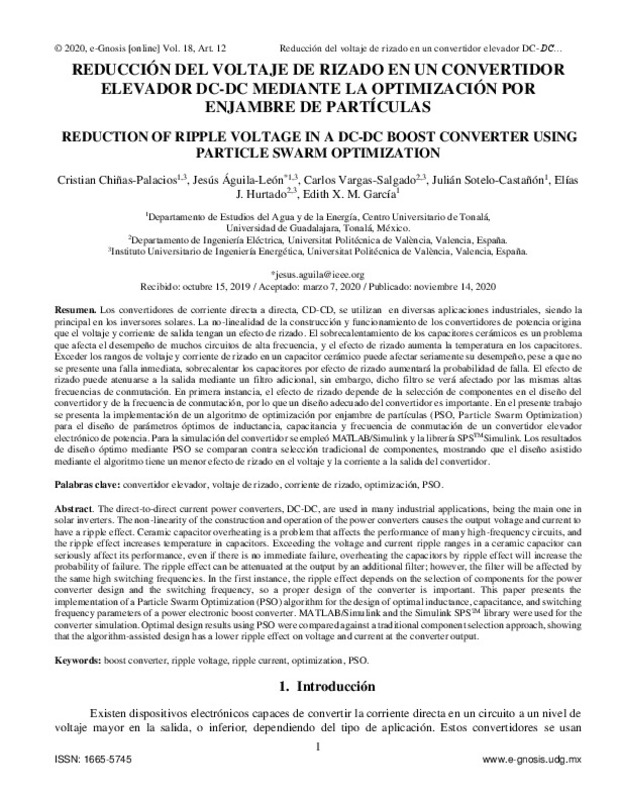JavaScript is disabled for your browser. Some features of this site may not work without it.
Buscar en RiuNet
Listar
Mi cuenta
Estadísticas
Ayuda RiuNet
Admin. UPV
Reducción del voltaje de rizado en un convertidor elevador DC-DC mediante la optimización por enjambre de partículas
Mostrar el registro sencillo del ítem
Ficheros en el ítem
| dc.contributor.author | Chiñas-Palacios, Cristian
|
es_ES |
| dc.contributor.author | Águila-León, Jesús
|
es_ES |
| dc.contributor.author | Vargas-Salgado, Carlos
|
es_ES |
| dc.contributor.author | Sotelo Castañón, Julián
|
es_ES |
| dc.contributor.author | Hurtado-Perez, Elias
|
es_ES |
| dc.contributor.author | García, Edith X. M.
|
es_ES |
| dc.date.accessioned | 2021-02-11T04:32:00Z | |
| dc.date.available | 2021-02-11T04:32:00Z | |
| dc.date.issued | 2020 | es_ES |
| dc.identifier.uri | http://hdl.handle.net/10251/161040 | |
| dc.description.abstract | [ES] Los convertidores de corriente directa a directa, CD-CD, se utilizan en diversas aplicaciones industriales, siendo la principal en los inversores solares. La no-linealidad de la construcción y funcionamiento de los convertidores de potencia origina que el voltaje y corriente de salida tengan un efecto de rizado. El sobrecalentamiento de los capacitores cerámicos es un problema que afecta el desempeño de muchos circuitos de alta frecuencia, y el efecto de rizado aumenta la temperatura en los capacitores. Exceder los rangos de voltaje y corriente de rizado en un capacitor cerámico puede afectar seriamente su desempeño, pese a que no se presente una falla inmediata, sobrecalentar los capacitores por efecto de rizado aumentará la probabilidad de falla. El efecto de rizado puede atenuarse a la salida mediante un filtro adicional, sin embargo, dicho filtro se verá afectado por las mismas altas frecuencias de conmutación. En primera instancia, el efecto de rizado depende de la selección de componentes en el diseño del convertidor y de la frecuencia de conmutación, por lo que un diseño adecuado del convertidor es importante. En el presente trabajo se presenta la implementación de un algoritmo de optimización por enjambre de partículas (PSO, Particle Swarm Optimization) para el diseño de parámetros óptimos de inductancia, capacitancia y frecuencia de conmutación de un convertidor elevador electrónico de potencia. Para la simulación del convertidor se empleó MATLAB/Simulink y la librería SPSTM Simulink. Los resultados de diseño óptimo mediante PSO se comparan contra selección tradicional de componentes, mostrando que el diseño asistido mediante el algoritmo tiene un menor efecto de rizado en el voltaje y la corriente a la salida del convertidor. | es_ES |
| dc.description.abstract | [EN] The direct-to-direct current power converters, DC-DC, are used in many industrial applications, being the main one in solar inverters. The non-linearity of the construction and operation of the power converters causes the output voltage and current to have a ripple effect. Ceramic capacitor overheating is a problem that affects the performance of many high-frequency circuits, and the ripple effect increases temperature in capacitors. Exceeding the voltage and current ripple ranges in a ceramic capacitor can seriously affect its performance, even if there is no immediate failure, overheating the capacitors by ripple effect will increase the probability of failure. The ripple effect can be attenuated at the output by an additional filter; however, the filter will be affected by the same high switching frequencies. In the first instance, the ripple effect depends on the selection of components for the power converter design and the switching frequency, so a proper design of the converter is important. This paper presents the implementation of a Particle Swarm Optimization (PSO) algorithm for the design of optimal inductance, capacitance, and switching frequency parameters of a power electronic boost converter. MATLAB/Simulink and the Simulink SPSTM library were used for the converter simulation. Optimal design results using PSO were compared against a traditional component selection approach, showing that the algorithm-assisted design has a lower ripple effect on voltage and current at the converter output. | es_ES |
| dc.language | Español | es_ES |
| dc.publisher | Universidad de Guadalajara | es_ES |
| dc.relation.ispartof | e-Gnosis | es_ES |
| dc.rights | Reconocimiento - No comercial - Compartir igual (by-nc-sa) | es_ES |
| dc.subject | Convertidor elevador | es_ES |
| dc.subject | Voltaje de rizado | es_ES |
| dc.subject | Corriente de rizado | es_ES |
| dc.subject | Optimización | es_ES |
| dc.subject | PSO | es_ES |
| dc.subject | Boost converter | es_ES |
| dc.subject | Ripple voltage | es_ES |
| dc.subject | Ripple current | es_ES |
| dc.subject | Optimization | es_ES |
| dc.subject.classification | INGENIERIA ELECTRICA | es_ES |
| dc.title | Reducción del voltaje de rizado en un convertidor elevador DC-DC mediante la optimización por enjambre de partículas | es_ES |
| dc.title.alternative | Reduction of ripple voltage in a DC-DC boost converter using particle swarm optimization | es_ES |
| dc.type | Artículo | es_ES |
| dc.rights.accessRights | Abierto | es_ES |
| dc.contributor.affiliation | Universitat Politècnica de València. Departamento de Ingeniería Eléctrica - Departament d'Enginyeria Elèctrica | es_ES |
| dc.description.bibliographicCitation | Chiñas-Palacios, C.; Águila-León, J.; Vargas-Salgado, C.; Sotelo Castañón, J.; Hurtado-Perez, E.; García, EXM. (2020). Reducción del voltaje de rizado en un convertidor elevador DC-DC mediante la optimización por enjambre de partículas. e-Gnosis. 18:1-8. http://hdl.handle.net/10251/161040 | es_ES |
| dc.description.accrualMethod | S | es_ES |
| dc.relation.publisherversion | http://www.e-gnosis.udg.mx/ | es_ES |
| dc.description.upvformatpinicio | 1 | es_ES |
| dc.description.upvformatpfin | 8 | es_ES |
| dc.type.version | info:eu-repo/semantics/publishedVersion | es_ES |
| dc.description.volume | 18 | es_ES |
| dc.identifier.eissn | 1665-5745 | es_ES |
| dc.relation.pasarela | S\422055 | es_ES |






